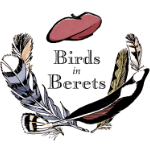
A multicolored mystery suggested by Kristen K.
My Flicker is Yellow (But Yours Might Not Be)
When I received Kristen’s request for a Northern Flicker, I was at that very moment looking out my studio window at the female Northern Flicker who had lived and raised a family just across the lawn. I live in Middle Tennessee, so the flicker family in my neighborhood are large, slender speckled birds with red napes and brilliant yellow flashes beneath their wings. I realized that if Kristen was watching her own neighborhood flicker family, their wings could be any color from goldenrod to peach. This is because Kristen is lives in a part of the continent where Flickers can be any color from yellow to copper to pink–but to explain that we’ll have to look closer at Northern Flickers and the biologists who study them.
Abundant, Conspicuous, and Unexpectedly Confusing
Northern Flickers are a large, conspicuous, and abundant clan of woodpeckers that live in virtually every region of North America. The entire clan of Northern Flickers sport dark tan wings and back decorated with black bars, spotted buff bellies, and prominent white rump patches. and a black, crescent shaped scarf decorating their throat. Flickers in the Eastern half of North America have flight feathers with brilliant gold shafts, which are visible as vivid yellow flashes during flight. The males have prominent black mustaches and both sexes have soft tan faces a red stripe at the nape of their necks. In the west, Northern Flickers have red-shafted flight feathers, gray faces, and, in males, red mustache markings.
This variation in color morphology led ornithologists in the 1800s to (mostly) accept them as two different species–the Red-shafted Flicker in the west and the Yellow-shafted Flicker in the east. This is still a common way for birders to describe their woodpecker sightings. However, the taxonomy was already problematic by 1843, when John James Audubon himself came across a nest of five Flicker fledgelings. Recording the find in his journal, he wrote that it “will puzzle all the naturalists in the world”. This was because some were red-shafted, some were yellow-shafted, and a few were in-between!
Flicker Feathers and the Genetics of Color
Audubon didn’t know it yet, but his findings helped define a Hybrid Zone–the name biologists give to part of a species’ range where individuals with different regional characteristics interbreed. Northern Flickers within the hybrid zone can have feather shafts of any shade from vermillion to goldenrod. A single clutch of eggs can have as many variations as there are chicks! Other ornithologists eventually confirmed that the Northern Flicker Hybrid Zone runs from northern Montana down through Colorado and Nebraska to a thin sliver of New Mexico. This indicated that Yellow-shafted and Red-shafted flickers might actually be two morphs of the same species.
The mystery doesn’t stop there, though! Whereas many bird species have regionally-defined color morphology that affects the overall color of the bird, Northern Flicker coloration displays differences in very specific areas of the birds’ plumage. Even for later ornithologists with more extensive knowledge of genetics, it was hard to explain how two birds could have enough similar DNA to be the same species while exhibiting differences as striking as the presence or absence of the eastern Flickers’ red nape patch. Even further complicating things, the pigments responsible for the coloring were wildly different on a chemical level. How could these birds not only synthesize multiple pigment types but also swap and interchange them so freely?
Solving It With Sequencing
The extensive interbreeding of the two Flicker colors turned out to be key to more mysteries than one. The wild population created a much larger variety in color combinations than could be created independently, and featured differences in six different areas of the birds’ plumage. With closer study, it turned out that these six markings could differ independently from each other. That made the perfect pool of data for experiments comparing the nature of feather pigments, the interaction of the genes that cause them, and how those genes are inherited.
In 2001, Stephanie M. Aguillon published a doctoral dissertation in which she shared the findings of extensive genomic sequencing of hybrid Northern Flickers. Aguillon’s research demonstrated conclusively that the birds differ in an infinitesimal fraction of their DNA. This put it beyond doubt that the Flickers were similar enough to be one species. Further, her research on how the few differing genes work together to influence the distinctive coloration of Northern Flickers provided a stepping stone to new understanding of birds’ markings. The data added to biologists’ knowledge of how several genes interact to define marking placement on birds and animals. It also suggested new insights about the different kinds of organic chemicals that function as pigments within feather tissues.
You’d think that this would be the whole story, but it isn’t.
Ok, What About The Pink Ones?
Right in the middle of a century of research on Flicker hybridization, biologists in the 1960s discovered another population of odd-colored birds. The coppery, pinkish feather shafts looked similar to hybrid Flickers, but these birds were thousands of mile east of the Hybrid Zone. It’s no surprise that the researchers began trying to trace the lineage by which western Flicker DNA might have spread so far east. They are migratory, after all. This hypothesis turned out to be nearly a fifty-year distraction.
It wasn’t until 2016 when Jocelyn Hudon and his Canada-based team thought to compare the two types of red feathers. Extracting the pigment from specimens in the Royal Alberta Museum, they found they had two different types of red. One was a common pigment in bird feathers, but one was an unusual, plant-based pigment called rhodoxanthin. The team deduced that they’d find an edible plant that created a significant quantity of rhodoxanthin, within the range of the Eastern birds with the pinkish feathers, at a time when the birds were molting. Since rhodoxanthin is rare in nature, it wasn’t long before they narrowed it down to invasive honeysuckle berries.
So what’s the point? Just that birds are cool, and you now have a whole rainbow of woodpeckers to get out there and see!
My Suggestions for Spotting one of these Spotted Darlings
Back to birding. If you live in North America, there’s a good chance you’ve seen one of these multicolored mysteries already. But, if you haven’t, there’s no reason you can’t! Individuals have been documented breeding as far north as Saskatchewan and wintering as far south as Nicaragua. Since they migrate in daylight, birders here in the eastern U.S. get to look forward to seeing flocks of flickers in the fall and spring, in addition to the summer-long friendship and annual return of local flicker families. According to their entry in the Audubon Field Guide, flickers on the west coast tend to travel solo or in smaller groups, but that’s no reason not to get excited for extra flicker sightings!
The best place to look for a Northern Flicker will have some open ground, some nearby trees, and hopefully some undisturbed leaf litter. Unlike most woodpeckers, Flickers like to rummage on the ground for much of their diet. They’ll also hunt around and under bark, and you can still zero in on their location by their drumming. Just remember that they prefer perching on branches, rather than clinging to trunks. Like most woodpecker species, they make most of their meals on bugs and invertebrates, but don’t be surprised to find one snacking on berries, too. In fact, don’t rule them out if you find a speckled bird doing just about any “un-woodpeckerish” activity. They’re nonconformists, and play by their own rules. Just wait until they fly, and confirm your I.D. by the yellow (or red, or salmon, or tangerine) flashes!
Character Design
There are a lot of distinct features in Northern Flickers, both visually and in their behaviors. We’ve talked about a couple, but we’ve actually barely scratched the surface of what makes them so unusual. Their completely self-assured nonconformity needed to be part of the posing and design for this bird, as did a prominent view of their distinctive flight feathers. Further, I wanted to include their unique preference for horizontal perches. Finally, the design needed to convey that they’re quite large–about halfway between the size of a robin and the size of a crow.
To get the size right, I chose to substantially simplify the shape of his breast and belly. His feathers fluff out, and his upright posture hides his dark wings behind the curve of his torso. This removed the dark framing from the form of his body, allowing the light-colored shape to expand visually into the space. Flickers naturally have short, blunt tails, but I shortened and widened the tail in the drawing to further emphasize bulk.
For the cheekiness, I started with an almost sarcastic side-eye. the sideways turn of the head and direct gaze out of the frame help give him an air of self-assuredness. It also helps show off the distinctive black mustache marking present in male yellow-shafted Northern Flickers. The beret ends up viewed from the side, but its position suggests that it’s sitting squarely atop his head as he looks you squarely in the eye. The contrasting-yet-fashionable green helps emphasize that this bird lives his own life and stands by his own choices.
Working on this sketch also made me realize that I would absolutely dress to match a Northern Flicker. The bold color and geometric pattern on the tail, the subtly spotted breast and belly, and the red accent at the nape of the neck would all carry over into a fantastic classy-casual look. I’d copy the yellow-shafted ones, because I want the red neckerchief/hair bow in the mix. Add an awesome yellow pencil skirt and a polka-dot cardigan and I’d be set! Oh, and I’m not forgetting the beret…
Tips on Identifying Northern Flickers:
As usual, Cornell Lab has everything you need to I.D. these large woodpeckers right here
Research I Referenced:
Read the published research on flicker hybridization and color patterning in feathers here.
Audubon also has a great write-up about flickers dyed pink by a diet of honeysuckle berries here. And–you guessed it–here’s the published science behind the honeysuckle berry discovery!

